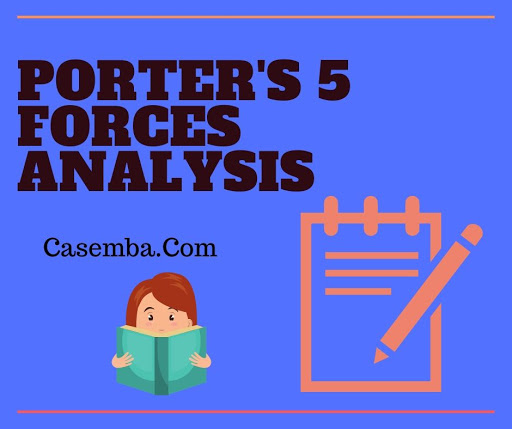Porter's Five Forces of When To Drop An Unprofitable Customer (Hbr Case Study And Commentary) Case Study Solution
This is not the actual case solution. To get the case solution place your order on the site and contact website support.
Home >> Robert S Kaplan >> When To Drop An Unprofitable Customer (Hbr Case Study And Commentary) >> Porters Analysis
Porter's 5 Forces of When To Drop An Unprofitable Customer (Hbr Case Study And Commentary) Case Help
The porter 5 forces design would help in gaining insights into the Porter's Five Forces of When To Drop An Unprofitable Customer (Hbr Case Study And Commentary) Case Analysis industry and measure the possibility of the success of the alternatives, which has been considered by the management of the business for the purpose of dealing with the emerging problems connected to the lowering subscription rate of consumers.
1. Intensity of rivalry
 It is to inform that the Porter's 5 Forces of When To Drop An Unprofitable Customer (Hbr Case Study And Commentary) Case Help belongs of the multinational show business in the United States. The business has actually been taken part in providing the services in more than ninety countries with the video as needed, items of streaming media and media company.
It is to inform that the Porter's 5 Forces of When To Drop An Unprofitable Customer (Hbr Case Study And Commentary) Case Help belongs of the multinational show business in the United States. The business has actually been taken part in providing the services in more than ninety countries with the video as needed, items of streaming media and media company.
The industry where the Porter's Five Forces of When To Drop An Unprofitable Customer (Hbr Case Study And Commentary) Case Solution has actually been operating because its creation has many market players with the substantial market share and increased earnings. There is an intense level of competition or competition in the media and entertainment market, engaging organizations to aim in order to keep the current clients via using services at budget-friendly or reasonable costs.
Quickly, the strength of rivalry is strong in the market and it is essential for the company to come up with distinct and innovative offerings as the audience or customers are more sophisticated in such contemporary technology era.
2. Threats of new entrants
There is a high cost of entrance in the media and entrainment industry. The show business requires a big capital quantity as the companies which are engaged in supplying entertainment service have larger start-up expense, which includes:
Legal cost.
Marketing expense.
Distribution cost.
Licensing cost.
In contrast, the existing home entertainment company has been extensively working on their targeted segments with the specific specialization, which is why the hazard of brand-new entrants is low.
Another important aspect is the strength of competitors within the key market players in the market, due to which the brand-new entrant hesitate while entering into the market. The innovation and trends in the media market are evolving on constant basis, which is adapted by market rivals and Porter's Five Forces of When To Drop An Unprofitable Customer (Hbr Case Study And Commentary) Case Help.
3. Threat of substitutes
The danger of alternatives in the market posture moderate danger level in media and the home entertainment industry. The consumer may likewise engage in other leisure activities and source of details as compared to watching media content and online streaming.
4. Bargaining power of buyer
The dynamics of media and home entertainment market permits the customers to have high bargaining power. The low cost of changing makes it possible for the clients to seek other media service providers and cancel their Porter's Five Forces of When To Drop An Unprofitable Customer (Hbr Case Study And Commentary) Case Help membership, thus increasing the company threat.
5. Bargaining power of suppliers
Considering that Porter's Five Forces of When To Drop An Unprofitable Customer (Hbr Case Study And Commentary) Case Analysis has actually been contending against the conventional distributor of home entertainment and media, it needs to reveal greater flexibility in arrangement as compared to the conventional businesses. The products is technology based, the dependence of the business are increasing on constant basis.
Goals and Objectives of the Company:
In Illinois, United States of America, one of the best producer of sensing unit and competitive company is Case Option. The organization is associated with production of wide product range and advancement of activities, networks and procedures for achieving success among the competitive environment of industry offering it a substantial advantage over competitiveness. The organization's goals is principally to be the maker of sensing unit with high quality and extremely customized company surrounded by the premium market of sensor manufacturing in the United States of America.
The objective of the company is to bring decrease in the item costs by increasing the sales system for every item. The organizational management is involved in determination of potential products to offer their consumer in both long term and brief term suggests. The organizational strength includes the facility of competitive position within the manufacturing market of sensor in the United States of America on the basis of 5 pillars which includes customer care, performance in operation management, recognition of brand, personalized abilities and technical development.
The organization is a leading one and carrying out as a leader in the sensing unit market of the United States for their adjustable services and systems of sensing unit. Innovation in principles and item developing and arrangement of services to their consumers are among the competitive strengths of the company. The company has actually used cross-functional managers who are responsible for change and understanding of the company's method for competitiveness whereas, the organization's weak point includes the decision making in regard to the products' removal or retention only on the basis of monetary aspects. The measurement of ROIC is not associated with the trade incorporation and concerns of consumers.
